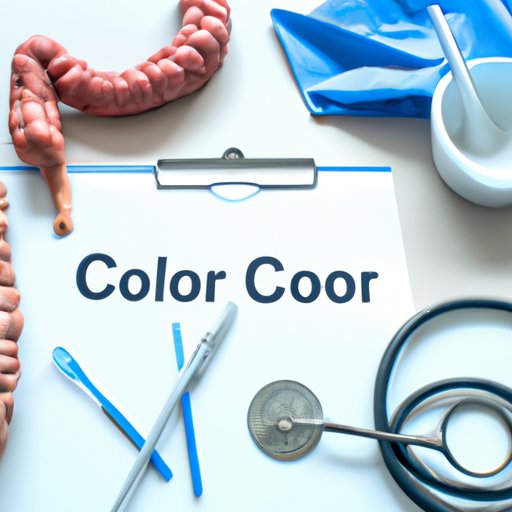Introduction
Colonoscopies are one of the most important medical procedures for detecting and preventing colon cancer. A colonoscopy enables your doctor to see inside your large intestine, or colon, and identify any abnormalities that may be present. Read on to learn more about what a colonoscopy entails, the reasons you may need to get one, and how to prepare for the procedure.
Overview of Colonoscopy Procedure
Colonoscopy is a procedure in which a thin, flexible tube with a tiny camera on the end, called a colonoscope, is inserted into the rectum and guided through the entire length of the large intestine. The camera transmits images of the inside of the colon to a video monitor, allowing your doctor to look for any signs of disease or other abnormalities. During the procedure, your doctor may take biopsies to test for cancerous cells or remove polyps, which are benign growths that can become cancerous if left untreated.

Reasons for Getting a Colonoscopy
Your doctor may recommend a colonoscopy to screen for colorectal cancer or to investigate certain symptoms such as abdominal pain, rectal bleeding, changes in bowel habits, or unexplained weight loss. Colonoscopies are also recommended for people over the age of 50 who have not had any symptoms, as this is when the risk of developing colon cancer begins to increase. Your doctor may also recommend a follow-up colonoscopy after an abnormal result from a fecal occult blood test (FOBT) or sigmoidoscopy.
Steps Involved in a Colonoscopy
Pre-Procedure Preparation
Before your colonoscopy, your doctor will provide detailed instructions on how to prepare for the procedure. This typically includes following a clear liquid diet for one to three days beforehand, along with taking a laxative or enema to help empty the bowels. It is important to follow these instructions carefully to ensure the best possible results from the procedure.
The Actual Procedure
The actual colonoscopy procedure usually takes between 30 minutes and an hour. During the procedure, you will lie on your side with your knees drawn up to your chest. Here are the steps involved in the procedure:
- Insertion of the Colonoscope: The doctor will insert the colonoscope into the rectum and slowly guide it through the entire length of the colon.
- Examining the Colon: The doctor will use the camera to examine the lining of the colon for any abnormalities.
- Taking Biopsies and Removing Polyps: If necessary, the doctor may take biopsies to test for cancerous cells or use specialized tools to remove any polyps that are found.
What to Expect During a Colonoscopy
Sedation
Most people receive some form of sedation during the procedure in order to make it more comfortable. This is usually done in the form of intravenous (IV) medication, although some doctors may use an oral sedative instead.
Discomfort
You may experience some mild discomfort during the procedure, such as cramping or bloating. However, most people find the procedure to be relatively painless.
Timeframe
The length of the procedure depends on several factors, such as the size of the colon and whether any polyps or other abnormalities are found. Generally, the procedure takes between 30 minutes and an hour.

Benefits of Getting a Colonoscopy
Early Detection and Prevention of Colon Cancer
Colonoscopies are one of the best ways to detect colorectal cancer in its early stages, when it is most treatable. Having regular colonoscopies can also help prevent colon cancer by identifying and removing precancerous polyps before they have a chance to develop into cancer.
Identification and Treatment of Other Digestive Issues
In addition to detecting cancer, a colonoscopy can also be used to identify and treat other digestive issues, such as inflammatory bowel disease (IBD), diverticulosis, and ulcerative colitis.

Risks and Side Effects of Colonoscopy
Possible Complications
Although rare, complications can occur during a colonoscopy. These include perforation of the colon, infection, and reactions to the sedatives used during the procedure.
Bleeding
You may experience some light bleeding after the procedure, particularly if polyps were removed or biopsies were taken. This is usually minor and will stop on its own, but if it persists or worsens, contact your doctor.
Preparing for a Colonoscopy
Dietary Restrictions
It is important to follow your doctor’s instructions on how to prepare for the procedure. This usually involves following a clear liquid diet for one to three days before the procedure and avoiding foods that can cause bloating or gas, such as dairy products, beans, and cruciferous vegetables.
Lifestyle Changes
You should also avoid alcohol and smoking for at least 24 hours before the procedure. Additionally, you should arrange for someone to drive you home after the procedure, as the sedatives used can impair your ability to drive.
Medication
Your doctor may also advise you to stop taking certain medications, such as blood thinners or aspirin, before the procedure. Be sure to follow your doctor’s instructions carefully.
Conclusion
Colonoscopies are invaluable medical procedures for detecting and preventing colon cancer. While the procedure itself can be uncomfortable, the benefits of getting a colonoscopy far outweigh any potential risks or side effects. By preparing properly for the procedure and following your doctor’s instructions, you can ensure the best possible outcome.
(Note: Is this article not meeting your expectations? Do you have knowledge or insights to share? Unlock new opportunities and expand your reach by joining our authors team. Click Registration to join us and share your expertise with our readers.)
